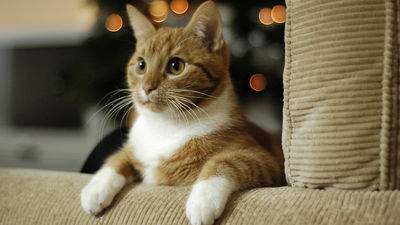How can you not be disliked by stroking cats?

by
There should be many people who want to pat the fluffy fur of the cat, but if you actually try to pat the cat, you will run away to somewhere or be turned with a grumpy face There is also a lot of loss. It is said that there is a 'method that does not dislike being hated by cats' which seems to be useful at such time.
How to stroke a cat, according to science
https://theconversation.com/how-to-stroke-a-cat-according-to-science-116025
Lauren Finca, a postdoctoral researcher at the University of Nottingham Trent , pointed out that it is necessary to go back to the origin of cats to reject them. The origin of cats widely kept in the modern age is considered to be the Libyan cat, and cats have been domesticated by humans and have begun to live together for at least several thousand years.
Although cats if there thousands of years might think that it is sufficient to adapt to the life of a human being, (PDF file) that it is not so large genetic differences between modern cat and ancestor research also There is. According to Finca, the cat's brain is still almost the same as a wild cat.
Wild cats basically live in a lonely life, and individuals do not look at each other directly, but communicate via indirect visual and chemical traces. Human beings, on the other hand, are social animals and prefer direct contact and love expression. Humans see the big eyes and wide foreheads of cats and feel 'cute' and feel they want to turn them, but it is natural that this communication is regarded as 'painful' for cats that take over the gene of wild cats. Well, Finca argues.

by
However, cats don't like being able to do anything from humans , and they sometimes give priority to being able to do things from humans rather than meals . A cat who knows the pleasure of being able to stroke in 2 to 7 weeks after birth seems to prefer to be able to be stroked by humans thereafter. In addition, the gender and character of human beings and how they usually interact with cats are also related to whether cats prefer to be able to stroke.
Also, some cats may refuse actively if they don't like being able to stroke, but some cats may allow it to be eaten in order to get food and bedding. However, tolerable cats are not always happy, and cats who feel that the owner is 'bearable to be able to beat' tend to have high stress levels .
In general, cats prefer to be able to stroke the base of the ear, under the chin, around the cheek, etc., rather than the stomach and back, Finca said. In addition, in order to avoid being disliked by cats, it is important to 'give the right of choice to cats', and it is ' only when the intention is displayed that the cat wants to stroke ' ' cat touches It is important to write the place where you want it to be and to stop the cat if it wants to leave .

by
However, since cats do not speak words, it is also difficult to really judge whether cats are hated or not. So Finca explains the point in identifying whether a cat is delighted or hated.
◆ Sign that a cat is pleased
・ Stand your tail vertically, and come close to wanting to stroke.
・ Through my throat, I touch it with my front leg.
• Slowly swing the tail left and right in the air.
・ Take your ears forward with a relaxed posture and expression.
・ I touch to prompt you to stop stroking.

by
◆ Sign that a cat dislikes
・ Turn your head away from the person who is stroking or turn it in another direction.
・ We are making a reaction such as ringing our throat uneasy.
Frequent blinks, shaking of head and body, licking nose.
・ Grow up quickly.
・ My back cramps and waves.
-Swing the tail.
・ The ear points to the side or back.
・ Scribbles with the legs.

by Larissa Barbosa
After all, as the cat strongly inherits the blood of the wild cat, 'it's important to respect the will of the cat, even if you're a little nervous,' says Finka.
Related Posts:
in Creature, Posted by log1h_ik







